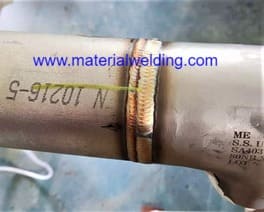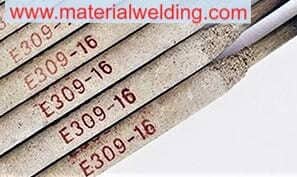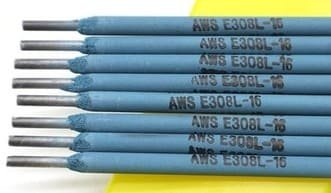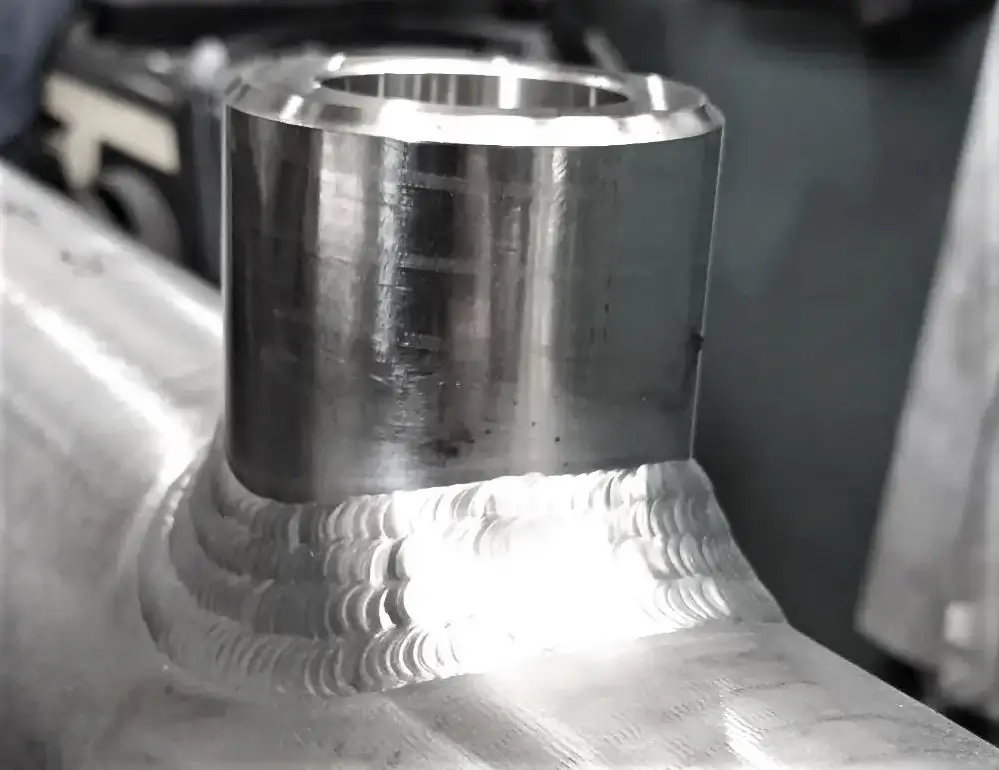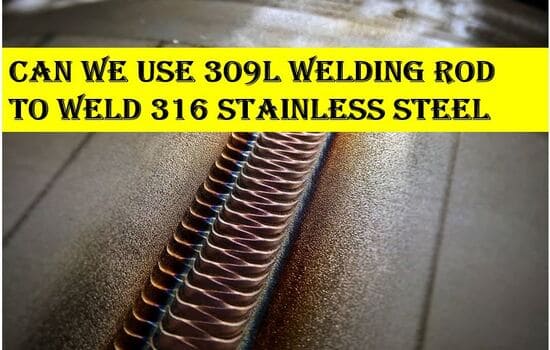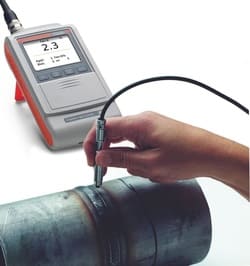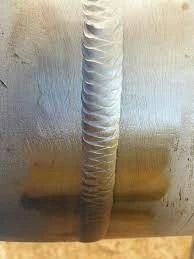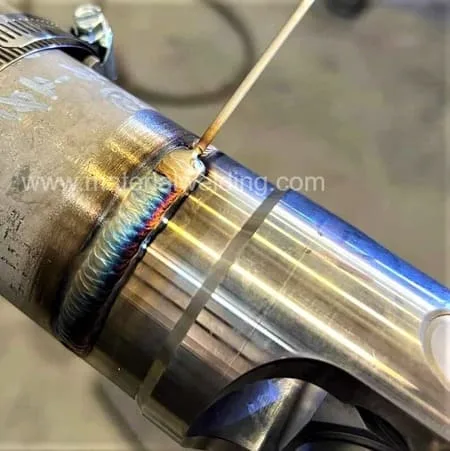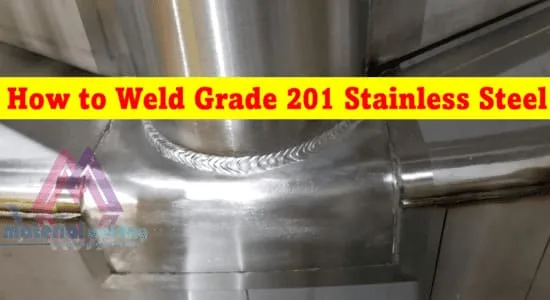E308L vs E309L electrodes are both stainless steel electrodes as per AWS A5.4. 309L is typically used for dissimilar welding applications, while 308L is more commonly used for welding austenitic stainless steel such as 302, 304L, 308 and CF-8 Grade.
E308L vs E309L electrodes offer different benefits depending on the application. For example, 309L provides better corrosion resistance and higher operating temperature limit than 308L, making it ideal for dissimilar welding applications.
However, 308L offers superior weldability and lower carbon content, making it a better choice for welding austenitic stainless steel materials.
E308L vs E309L Chemical Composition
The main difference between E308L vs E309L considering the chemical composition is the higher amount of Chromium and Nickel present in E309L compared to E308L.
The chemical composition of both E308L vs E309L are given in the below table (Reference: AWS A5.4).
| Element | E308L | E309L |
|---|---|---|
| Carbon % | 0.04 Max. | 0.04 Max. |
| Chromium % | 18- 21 | 22- 25 |
| Nickel % | 9- 11 | 12- 14 |
| Molybdenum % | 0.75 Max. | 0.75 Max. |
| Manganese % | 0.5 -2.5 | 0.5 -2.5 |
| Silicon % | 1.00 Max. | 1.00 Max. |
| Sulfur % | 0.03 Max. | 0.03 Max. |
| Phosphorus % | 0.04 Max. | 0.04 Max. |
| Copper % | 0.75 Max. | 0.75 Max. |
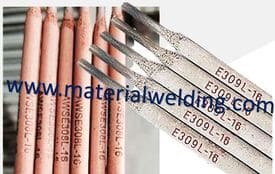
E308L vs E309L Mechanical Properties
When we compare E308L to E309L on mechanical strength scale, E309L is the winner. E309L has higher tensile strength of 80 Ksi compared to E308Lof 75 Ksi.
The yield strength and toughness properties of E308L or E309L are not specified in AWS A 5.4 as they can vary based on the heat input conditions in welding. In the below E308L vs E309L mechanical properties are compared.
| Properties | E308L-16 | E309L-16 |
|---|---|---|
| Tensile Strength | 75 Ksi (520 MPa) | 80 Ksi (550 MPa) |
| Yield Strength | Not Specified (Typical 54- 61 Ksi) | Not Specified (Typical 65- 68 Ksi) |
| Elongation | 30% minimum | 30% minimum |
| Toughness | Not specified | Not specified |
| Ferrite % | 10- 18 FN | 8 -9 FN |
E308L vs E309L Welding Applications
E308L is a versatile austenitic stainless steel stick welding rod used for welding of 302, 304L and 308 stainless steels. E308L is also used for welding of ASTM A743 & 744 Grade CF-8 Cast stainless steel welding.
E308L is a low carbon welding rod having smooth welding arc and resistant to intergranular corrosion for weld subjected to elevated temperature services.
On the other hand, E309L is a stick welding rod designed for dissimilar welding applications.
E309L is used for welding of stainless steel to mild steel, carbon steel and low alloy steel. E309L is also used for welding repair on 410 stainless steel to avoid PWHT. E309L has higher resistance to intergranular corrosion due to low carbon content.
Related reading: How to Weld Stainless Steel to Mild Steel- Complete Guide
Example applications of E309L are welding of 304 stainless steel to mild steel or carbon steel, welding barrier layer for weld overlay applications on carbon steel.
The general service temperature limit of 309L rod welding is 700°F (370°C). (Reference: AWS A2.4).
When should I use 308L 309L or 316L filler metal?
Filler metals are used in welding to contribute to add the metal, alloying elements and integrity of the final weld. When we talk about stainless steel welding, there are three main types of filler metal welding rod:
- 308L
- 309L
- 316L
308L is the most popular type of filler metal. It is versatile and can be used for a variety of applications. It is used for welding of 302, 304L and 308 stainless steels. E308L is also used for welding of ASTM A743 & 744 Grade CF-8 Cast stainless steel welding.
309L filler metal welding rod is a low carbon steel that is widely used in welding applications. 309L welding rod is austenitic stainless steel that is often used for welding dissimilar metals (e.g. welding stainless to carbon steel).
This rod provides good weldability and has excellent corrosion resistance. It is also resistant to pitting and crevice corrosion.
316L is a low-carbon austenitic chromium-nickel stainless steel with molybdenum added. The addition of molybdenum increases the corrosion resistance of 316L stainless steel over that of 304L stainless steel and gives it a higher degree of resistance to pitting and crevice corrosion.
316L is used as a filler metal for welding austenitic stainless steels 316L grade, including 304 and 304L.
In addition, 316L can be used for cladding or overlay applications on carbon or low-alloy steels to provide corrosion resistance without the need for post-weld heat treatment.
What is E308L?
E308L is the welding rod classification as per the AWS A5.4 specification. E308L is available in three usability characteristics:
- E308L-15
- E308L-16
- E308L-17
E308L is an austenitic stainless steel welding rod used to weld base metals of similar composition, including 302, 304L, and 308 stainless steels.
E308L is suitable for use in applications where corrosion resistance is a primary concern. The rod produces welds that are strong and resistant to corrosion.
Related Reading: Difference between E309L-15, 16 17, E316L-15,16 and 17
E308L is often used as a filler metal for TIG welding or MIG welding (equivalent filler wire as ER308L) of 304 and 308 stainless steels.
What is E309L?
E309L is a chromium-nickel-manganese welding rod used for welding dissimilar metals. The AWS A5.4 specification covers the composition and classification of this welding rod.
Related Reading:
E309L is an austenitic chromium-nickel-manganese stainless steel that is often used for welding dissimilar metals. This stainless steel has high levels of chromium and nickel, which gives it good corrosion resistance.
This welding rod can be used to weld ferritic steels to austenitic steels, as well as dissimilar metals such as carbon steel to stainless steel and it can also be used for cladding.
Can you use 309 to weld Stainless to Stainless?
The 309 number is assigned to a stainless steel electrode that can be used for welding mild steel, low-alloy high-strength steel, and stainless steel.
The main reason why welders would use the 309 electrode is because it can resist corrosion & provide good weldability for dissimilar welding.
However, it’s not recommended that you weld two pieces of stainless steel together with this electrode.
Other main reason for this is that the weld metal will have a lower corrosion resistance (due to high ferrite content) than the base metal.
This means that the weld area will be more susceptible to rust and corrosion over time. Additionally, the weld metal may also have a slightly different color than the base metal, which can be undesirable in some applications.
309L vs. 316L
There are many different grades of stainless steel, and each has its own benefits. Two of the most popular grades are 309L and 316L. Here’s a look at the key differences between them:
309L is ideal for dissimilar welding applications. his means that it can be used to weld two materials together that are not the same. For example, you could use 309L to weld stainless steel to carbon steel.
This is because 309L has a high level of chromium and nickel, which gives good corrosion resistance properties after weld dilution from carbon steel.
It can be used to weld austenitic stainless steel to ferritic stainless steel, as well as dissimilar metals like carbon steel.
| Element | E316L | E309L |
|---|---|---|
| Carbon % | 0.04 Max. | 0.04 Max. |
| Chromium % | 17- 20 | 22- 25 |
| Nickel % | 11- 14 | 12- 14 |
| Molybdenum % | 2.0- 3.0 | 0.75 Max. |
| Manganese % | 0.5 -2.5 | 0.5 -2.5 |
| Silicon % | 1.00 Max. | 1.00 Max. |
| Sulfur % | 0.03 Max. | 0.03 Max. |
| Phosphorus % | 0.04 Max. | 0.04 Max. |
| Copper % | 0.75 Max. | 0.75 Max. |
316L, on the other hand, is perfect for welding 316L stainless steel. This grade is highly resistant to corrosion and can withstand higher temperatures than other grades of stainless steel.
309 vs. 309L
The main difference between 309 and 309L is their carbon content. 309L (0.04 max) has a lower carbon content than 309 (up to 0.15%), which gives it better weldability and resistance to intergranular corrosion. But this reduces the strength of 309L compared to 309.
| Element | E309 | E309L |
|---|---|---|
| Carbon % | 0.15 Max. | 0.04 Max. |
| Chromium % | 22- 25 | 22- 25 |
| Nickel % | 12- 14 | 12- 14 |
| Molybdenum % | 0.75 Max. | 0.75 Max. |
| Manganese % | 0.5 -2.5 | 0.5 -2.5 |
| Silicon % | 1.00 Max. | 1.00 Max. |
| Sulfur % | 0.03 Max. | 0.03 Max. |
| Phosphorus % | 0.04 Max. | 0.04 Max. |
| Copper % | 0.75 Max. | 0.75 Max. |
309 vs. 309H
The main difference between 309 vs. 309H is that 309H usually has a higher carbon content, which gives it better creep resistance. Additionally, 309H has better corrosion resistance and higher temperature tolerance.
| Element | E309 | E309H |
|---|---|---|
| Carbon % | 0.15 Max. | 0.04- 0.15 |
| Chromium % | 22- 25 | 22- 25 |
| Nickel % | 12- 14 | 12- 14 |
| Molybdenum % | 0.75 Max. | 0.75 Max. |
| Manganese % | 0.5 -2.5 | 0.5 -2.5 |
| Silicon % | 1.00 Max. | 1.00 Max. |
| Sulfur % | 0.03 Max. | 0.03 Max. |
| Phosphorus % | 0.04 Max. | 0.04 Max. |
| Copper % | 0.75 Max. | 0.75 Max. |
Both 309 and 309H can be used in high-temperature applications like furnaces and boilers. However, due to its increased creep resistance, 309H is the better choice for long-term use at high temperatures.
Additionally, because of its increased corrosion resistance,309H is also often used in chemical processing plants and other harsh environments.
309L vs. 309LMo
When choosing a stainless steel filler metal, the decision often comes down to 309L or 309LMo. Both alloys are very similar, but there are some important differences to consider.
| Element | E309LMo | E309L |
|---|---|---|
| Carbon % | 0.04 Max. | 0.04 Max. |
| Chromium % | 22- 25 | 22- 25 |
| Nickel % | 12- 14 | 12- 14 |
| Molybdenum % | 2.0- 3.0 | 0.75 Max. |
| Manganese % | 0.5 -2.5 | 0.5 -2.5 |
| Silicon % | 1.00 Max. | 1.00 Max. |
| Sulfur % | 0.03 Max. | 0.03 Max. |
| Phosphorus % | 0.04 Max. | 0.04 Max. |
| Copper % | 0.75 Max. | 0.75 Max. |
309L is the most commonly used stainless steel filler metal for general-purpose applications. It has good weldability and can be used with all welding processes. However, it is not resistant pitting corrosion.
- 309LMo is often used in high-temperature applications. The addition of molybdenum increases the creep resistance of this grade, making it ideal for use in elevated-temperature environments.
- 309LMo is an alloy that contains molybdenum, which improves its creep resistance and pitting resistance. It also has a higher carbon content than 309L, which gives it better high temperature properties. However, this higher carbon content can make it more difficult to weld.
